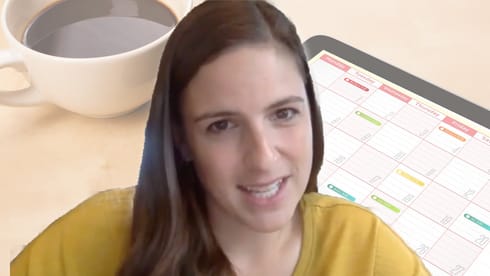Commonplacing for Moms: 10 Tips to Get Started

A commonplace is a notebook for keeping favorite quotes, inspiring ideas, or thoughtful notes. It’s a highly individual practice that has been used by “keepers” of all walks of life for nearly as long as the means to conveniently and cheaply read and write have been available.
It’s making a resurgence in the classical education world as well as the Charlotte Mason community because both recognize that learning is a process of the student’s mind acting on the material. Choosing and writing inspiring quotes and thoughts is one way to make ideas one’s own, to think more deeply and more clearly, and to slow down the reading pace to be more thoughtful and intentional.
So common placing is one method used in education, but first and foremost, it is a personal habit that intelligent, thoughtful people have been doing for hundreds of years. We would do well to imitate them ourselves and learn this habit, whether or not we teach it to our children.
As a homeschool practice, commonplacing has been gaining traction for years. With that traction comes many questions as people try to figure out the “right way” to build this habit. The short answer is that there really are no right answers, but the following 10 tips cover most of the concerns I hear most often.
After the 10 tips I’ve collected a number of helpful online articles and examples, and I hope that the comments section will provide still more examples, questions and answers, and tips from you! Sprinkled throughout are examples from my own commonplace notebooks.
Want extra commonplace tips and hand-holding? Check out the Scholé Sisters Commonplace Workshop!

Commonplacing Tip #1: Your commonplace is yours.
Don’t feel like someone else is doing it right and you need to copy their way of commonplacing. Commonplace notebooks are supposed to be highly individual, an expression of your own personality acting on your reading and learning.
Look at others’ books or techniques, or supplies, but only as ideas for things to try or ways to make it work. There is no one Right Way.

Commonplacing Tip #2: You will iterate your process.
You don’t have to wholeheartedly commit to one notebook or one pen or one page format or any set of conventions.
Just start, experiment, try out different methods and different materials, and find out what you like.
Don’t feel like you have to figure it all out before you begin. Just begin, and learn how to do it by practicing and experimenting. Your own process can and should evolve over time.
Commonplacing Tip #3: Find your roadblocks and tackle them.
For me, having a nice journal wasn’t appealing, it was intimidating. So I started with a cheap spiral notebook I wasn’t afraid to waste, ruin, or mess up.
Figuring out what’s holding you back from common placing is the best place to start. Usually there’s an easy fix because the hurdle is mental or emotional, so simply recognizing it is half way to overcoming it.

Commonplacing Tip #4: Know why you’re doing it.
Knowing why you’re keeping your commonplace will help you figure out how to make choices and get started amidst the varying practices you might find online.
Do you want to keep quotes to use or review handily? Maybe you want to transfer your commonplace selections to Evernote every so often so they are searchable. Or maybe you want to devise a color-coding or index system in your notebook so you can find quotes again when you want them.
However, if finding particular quotes isn’t a motivating factor, then you probably don’t need to have an index, color-coding, or archival system.
Commonplacing Tip #5: Give your commonplace supplies a home.
If you don’t know where your stuff is, you’ll always have a hurdle to overcome and you’re likely to simply never do it.
Create a reading corner or a book bag so your commonplace things have a home where they are ready whenever you are.
Commonplacing Tip #6: Reading time and commonplace time can be different.
I often sit with both my book and my notebook and pen so I can commonplace as I go. It’s a way to slow my reading down and think through ideas as I encounter them, otherwise I tend to speed through and not take the time to process well.
However, after awhile I found that I was avoiding reading the books that I really wanted to commonplace most simply because the time or space wasn’t conducive to handwriting (like sitting on the couch during piano lessons).
Sometimes I use book darts and sometimes I use post-it flags, but now when I don’t grab my commonplace, I grab a temporary place-marker and note what to commonplace while I’m reading. Then I can go back and commonplace later, which gives me a chance to revisit the ideas, too!

Commonplacing Tip #7: Keep digital storage in its place.
I do love Evernote, but I do not and I do not recommend commonplacing by typing unless your primary goal is having thorough research notes and quotations to pull later. If, instead, your goal is to read more deeply and think more carefully, nothing beats writing things out by hand.
However, I still do use Evernote after commonplacing by hand. Evernote is like my filing cabinet, so after I’ve finished a book or filled a notebook, I can go through and “scan” by phone-photos my notebook into Evernote, which in turn makes even handwritten notes searchable.
Win-win!
Update: I now use the Notion app instead of Evernote for digital notebooking.
Commonplacing Tip #8: Keep multiple notebooks – or just one.
I’m often asked whether it’s ok to have more than one commonplace or if it should be an all-in-one sort of practice.
The answer is that it’s entirely up to you! Again, there is no right way.
If you like to keep different types of books separate, or if you have different locations you read and want to duplicate supplies – make it work for you!
If you just want the simplicity of a single notebook, that works too.
Personally, I have 4: 1 for my Bible-reading, 1 for general reading and note taking (this one I take to conferences too for notes while listening), 1 for my current project of rereading my favorite educational philosophy books, and 1 specifically for my reading through The Great Tradition which I intend to be a research-reference summary when I’m done.

Commonplacing Tip #9: Make it appealing to you.
Really, all these tips could be summarized in this one tip. Make it work for you. Make it appealing to you. Do you like pretty notebooks? Choose one that will draw you in. Do pretty notebooks make it feel too intimidating? Start with a cheap simple notebook you won’t mind messing up in.
Commonplacing Tip #10: Don’t overthink it.
You don’t have to have it all figured out before you begin. Just start, and it’ll probably become clear because it’s really a simple process: write out what stands out to you so you can think about it, meditate on it, and return to it.
Don’t worry about what you’ll do with the notebook when you’re done – worry about that once you are done with it!
Don’t worry about your handwriting not being as lovely as you’d like or about whether it should include hand-lettering, stickers, doodles, color-coding, sketches, or whatever else you’ve seen done.
Pick a notebook, write or sketch as the inspiration comes. Let it be an aid to your learning, not a hindrance or hang-up. This is a timeless personal practice because of the surprising impact that simply writing out a beautiful thought has.
Start, and your process and practice will be refined over time. That is part of the beauty.

A Commonplace Collection
All the following are links I recommend to understand the process better or to see some examples of different individual’s practices.
- The Uncommon Commonplace (episode #83) at ScholeSisters.com
- How You Are Reading All Wrong by Pam Barnhill
- My Commonplace Book – A Lifelong Delight by Kathy Weitz
- Organizing My Commonplace by Celeste Cruz
- What I Keep in My Commonplace Book by Sarah Mackenzie
- Sparkly Gel Pens, a Webinar, and Other Commonplace Book Necessities by Brandy Vencel
- A Glimpse at Charlotte Mason’s Commonplace by Brandy Vencel
- How I Use My Commonplace Journal
- The Benefits of Keeping a “Commonplace Book” by Todd Henry
- Commonplace book at Wikipedia
Have more questions to ask or tips to share about commonplacing?
Join the discussion in the comments!
A part of my weekly digest newsletter, The Weekly Review, includes a snapshot of a commonplace entry from my reading that week. Sent out every Saturday morning, The Weekly Review offers an exclusive short attitude-management pep talk, links from the week, a snapshot and a brief paragraph about something I read that week, and a reminder to do your weekly review. Sign up for free!



